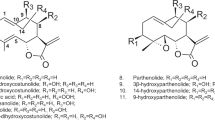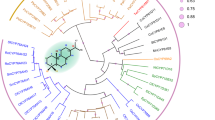Abstract
Many terpenes and terpenoid compounds are known as bioactive substances with desirable fragrance and medicinal activities. Modification of such compounds to yield new derivatives with desired properties is particularly attractive. Cytochrome P450 monooxygenases are potential enzymes for these reactions due to their capability of performing different reactions on a variety of substrates. We report here the characterization of CYP264B1 from Sorangium cellulosum So ce56 as a novel sesquiterpene hydroxylase. CYP264B1 was able to convert various sesquiterpenes including nootkatone and norisoprenoids (α-ionone and β-ionone). Nootkatone, an important grapefruit aromatic sesquiterpenoid, was hydroxylated mainly at position C-13. The product has been shown to have the highest antiproliferative activity compared with other nootkatone derivatives. In addition, CYP264B1 was found to hydroxylate α- and β-ionone, important aroma compounds of floral scents, regioselectively at position C-3. The products, 3-hydroxy-β-ionone and 13-hydroxy-nootkatone, were confirmed by 1H and 13C NMR. The kinetics of the product formation was analyzed by high-performance liquid chromatography, and the K m and k cat values were calculated. The results of docking α-/β-ionone and nootkatone into a homology model of CYP264B1 revealed insights into the structural basis of these selective hydroxylations.






Similar content being viewed by others
References
Arnold K, Bordoli L, Kopp J, Schwede T (2006) The SWISS-MODEL Workspace: a web-based environment for protein structure homology modelling. Bioinformatics 22:195–201
Bell SG, Dale A, Rees NH, Wong LL (2009) A cytochrome P450 class I electron transfer system from Novosphingobium aromaticivorans. Appl Microbiol Biotechnol 86:163–175
Bernhardt R (2006) Cytochromes P450 as versatile biocatalysts. J Biotechnol 124:128–145
Bicas JL, Dionisio AP, Pastore GM (2009) Bio-oxidation of terpenes: an approach for the flavor industry. Chem Rev 109:4518–4531
Borges KB, Borges WS, Durán-Patrón R, Pupo MT, Bonato PS, Collado IG (2009) Stereoselective biotransformations using fungi as biocatalysts. Tetrahedron-Asymmetry 20:385–397
Brenna E, Fuganti C, Serra S, Kraft P (2002) Optically ative inones and derivatives: preparation and olfactory properties. Eur J Org Chem 2002:967–978
Cankar K, an Houwelingen A, Bosch D, Sonke T, Bouwmeester H, Beekwilder J (2011) A chicory cytochrome P450 mono-oxygenase CYP71AV8 for the oxidation of (+)-valencene. FEBS Letters 585:178–182
Celik A, Flitsch SL, Turner NJ (2005) Efficient terpene hydroxylation catalysts based upon P450 enzymes derived from actinomycetes. Org Biomol Chem 3:2930–2934
Chu SS, Jiang GH, Liu ZL (2011) Insecticidal compounds from the essential oil of Chinese medicinal herb Atractylodes chinensis. Pest Manag Sci. doi:10.1002/ps.2180
Curci R, D’Accolti L, Fusco C (2006) A novel approach to the efficient oxygenation of hydrocarbons under mild conditions. Superior oxo transfer selectivity using dioxiranes. Acc Chem Res 39:1–9
Denisov IG, Makris TM, Sligar SG, Schlichting I (2005) Structure and chemistry of cytochrome P450. Chem Rev 105:2253–2278
Edris AE (2007) Pharmaceutical and therapeutic potentials of essential oils and their individual volatile constituents: a review. Phytother Res 21:308–323
Ewen KM, Hannemann F, Khatri Y, Perlova O, Kappl R, Krug D, Hüttermann J, Müller R, Bernhardt R (2009) Genome mining in Sorangium cellulosum So ce56: identification and characterization of the homologous electron transfer proteins of a myxobacterial cytochrome P450. J Biol Chem 284:28590–28598
Fraatz MA, Berger RG, Zorn H (2009) Nootkatone-a biotechnological challenge. Appl Microbiol Biotechnol 83:35–41
Fraga BM (2006) Natural sesquiterpenoids. Nat Prod Rep 23:943–972
Furusawa M, Hashimoto T, Noma Y, Asakawa Y (2005) Biotransformation of citrus aromatics nootkatone and valencene by microorganisms. Chem Pharm Bull (Tokyo) 53:1423–1429
Galani VJ, Patel BG, Rana DG (2010) Sphaeranthus indicus Linn.: a phytopharmacological review. Int J Ayurveda Res 1:247–253
Girhard M, Klaus T, Khatri Y, Bernhardt R, Urlacher VB (2010) Characterization of the versatile monooxygenase CYP109B1 from Bacillus subtilis. Appl Microbiol Biotechnol 87:595–607
Gliszczyńska A, Łysek A, Janeczko T, Świtalska M, Wietrzyk J, Wawrzeńczyk C (2011) Microbial transformation of (+)-nootkatone and the antiproliferative activity of its metabolites. Bioorg Med Chem 19:2464–2469
Guex N, Peitsch MC (1997) SWISS-MODEL and the Swiss-PdbViewer: an environment for comparative protein modelling. Electrophoresis 18:2714–2723
Hannemann F, Bichet A, Ewen KM, Bernhardt R (2007) Cytochrome P450 systems-biological variations of electron transport chains. Biochim Biophys Acta 1770:330–344
Hegazy M-EF, Kuwata C, Matsushima A, Ahmed AA, Hirata T (2006) Biotransformation of sesquiterpenoids having α-, β-unsaturated carbonyl groups with cultured plant cells of Marchantia polymorpha. J Mol Catalysis B: Enzymatic 39:13–17
Huey R, Morris GM, Olson AJ, Goodsell DS (2007) A semiempirical free energy force field with charge-based desolvation. J Comput Chem 28:1145–1152
Jung C, Ristau O, Rein H (1991) The high-spin/low-spin equilibrium in cytochrome P-450—a new method for determination of the high-spin content. Biochim Biophys Acta 1076:130–136
Khatri Y, Girhard M, Romankiewicz A, Ringle M, Hannemann F, Urlacher VB, Hutter MC, Bernhardt R (2010a) Regioselective hydroxylation of norisoprenoids by CYP109D1 from Sorangium cellulosum So ce56. Appl Microbiol Biotechnol 88:485–495
Khatri Y, Hannemann F, Ewen K, Pistorius M, Perlova D, Kagawa O, Brachmann N, Muller AO, Bernhardt R (2010b) The CYPome of Sorangium cellulosum So ce56 and identification of CYP109D1 as a new fatty acid hydroxylase. Chem Biol 17:1295–1305
Khatri Y, Hannemann F, Perlova O, Müller R, Bernhardt R (2011) Investigation of cytochromes P450 in myxobacteria: excavation of cytochromes P450 from the genome of Sorangium cellulosum So ce56. FEBS Lett 585:1506–1513
Larroche C, Creuly C, Gros JB (1995) Fed-batch biotransformation of β-ionone by Aspergillus niger. Appl Microbiol Biotechnol 43:222–227
Lepesheva GI, Podust LM, Bellamine A, Waterman MR (2001) Folding requirements are different between sterol 14alpha-demethylase (CYP51) from Mycobacterium tuberculosis and human or fungal orthologs. J Biol Chem 276:28413–28420
Loeber DE, Russell SW, Toube TP, Weedon BCL, Diment J (1971) Carotenoids and related compounds. Part XXVIII. Syntheses of zeaxanthin, β-cryptoxanthin, and zeinoxanthin (α-cryptoxanthin). J Chem Soc C:404–408
Luthra A, Denisov IG, Sligar SG (2011) Spectroscopic features of cytochrome P450 reaction intermediates. Arch Biochem Biophys 507:26–35
Lutz-Wahl S, Fischer P, Schmidt-Dannert C, Wohlleben W, Hauer B, Schmid RD (1998) Stereo- and regioselective hydroxylation of α-ionone by Streptomyces strains. Appl Environ Microbiol 64:3878–3881
Mikami Y, Fukunaga Y, Arita M, Kisaki T (1981) Microbial transformation of α-ionone and β-methyl-ionone. Appl Environ Microbiol 41:610–617
Miyazawa M, Nakamura Y, Ishikawa Y (2000) Insecticidal sesquiterpene from Alpinia oxyphylla against Drosophila melanogaster. J Agric Food Chem 48:3639–3641
Morris GM, Goodsell DS, Halliday RS, Huey R, Hart WE, Belew RK, Olson AJ (1998) Automated docking using a Lamarckian genetic algorithm and empirical binding free energy function. J Comput Chem 19:1639–1662
Munro AW, Lindsay JG, Coggins JR, Kelly SM, Price NC (1994) Structural and enzymological analysis of the interaction of isolated domains of cytochrome P-450 BM3. FEBS Lett 343:70–74
Murase T, Misawa K, Haramizu S, Minegishi Y, Hase T (2010) Nootkatone, a characteristic constituent of grapefruit, stimulates energy metabolism and prevents diet-induced obesity by activating AMPK. Am J Physiol Endocrinol Metab 299:266–275
Nishihara K, Kanemori M, Kitagawa M, Yanagi H, Yura T (1998) Chaperone coexpression plasmids:differential and synergistic roles of DnaK–DnaJ–GrpE and GroEL–GroES in assisting folding of an allergen of Japanese cedar pollen, Cryj2, in Escherichia coli. Appl Environ Microbiol 64:1694–1699
Omura T, Sato R (1964) The carbon monoxide-binding pigment of liver microsomes. I. Evidence for its hemoprotein nature. J Biol Chem 239:2370–2378
Ortiz de Montellano PR (2008) Mechanism and role of covalent heme binding in the CYP4 family of P450 enzymes and the mammalian peroxidases. Drug Metab Rev 40:405–426
Panella NA, Dolan MC, Karchesy JJ, Xiong Y, Peralta-Cruz J, Khasawneh M, Montenieri JA, Maupin GO (2005) Use of novel compounds for pest control: insecticidal and acaricidal activity of essential oil components from heartwood of Alaska yellow cedar. J Med Entomol 42:352–358
Poulos TL, Finzel BC, Howard AJ (1986) Crystal structure of substrate-free Pseudomonas putida cytochrome P-450. Biochemistry 25:5314–5322
Poulos TL, Finzel BC, Howard AJ (1987) High-resolution crystal structure of cytochrome P450cam. J Mol Biol 195:687–700
Quaderer R, Omura S, Ikeda H, Cane DE (2006) Pentalenolactone biosynthesis. Molecular cloning and assignment of biochemical function to PTLI, a cytochrome P450 of Streptomyces avermitilis. J Am Chem Soc 128:13036–13037
Ravichandran KG, Boddupalli SS, Hasemann CA, Peterson JA, Deisenhofer J (1993) Crystal structure of hemoprotein domain of P450BM-3, a prototype for microsomal P450’s. Science 261:731–736
Sanner MF (1999) Python: a programming language for software integration and development. J Mol Graph Model 17:57–61
Sauter IP, Dos Santos JC, Apel MA, Cibulski SP, Roehe PM, von Poser GL, Rott MB (2011) Amoebicidal activity and chemical composition of Pterocaulon polystachyum (Asteraceae) essential oil. Parasitol Res 2011:27
Schneiker S, Perlova O, Kaiser O, Gerth K, Alici A, Altmeyer MO, Bartels D, Beke T, Beyer S, Bode E, Bode HB, Bolten CJ, Choudhuri JV, Doss S, Elnakady YA, Frank B, Gaigalat L, Goesmann A, Groeger C, Gross F, Jelsbak L, Jelsbak L, Kalinowski J, Kegler C, Knauber T, Konietzny S, Kopp M, Krause L, Krug D, Linke B, Mahmud T, Martinez-Arias R, McHardy AC, Merai M, Meyer F, Mormann S, Munoz-Dorado J, Perez J, Pradella S, Rachid S, Raddatz G, Rosenau F, Rückert C, Sasse F, Scharfe M, Schuster SC, Suen G, Treuner-Lange A, Velicer GJ, Vorhölter FJ, Weissman KJ, Welch RD, Wenzel SC, Whitworth DE, Wilhelm S, Wittmann C, Blöcker H, Pühler A, Müller R (2007) Complete genome sequence of the myxobacterium Sorangium cellulosum. Nat Biotech 25:1281–1289
Schwede T, Kopp J, Guex N, Peitsch MC (2003) SWISS-MODEL: an automated protein homology-modeling server. Nucleic Acids Res 31:3381–3385
Takahashi S, Yeo Y, Greenhagen BT, McMullin T, Song L, Maurina-Brunker J, Rosson R, Noel JP, Chappell J (2007) Metabolic engineering of sesquiterpene metabolism in yeast. Biotechnol Bioeng 97:170–181
Tassaneeyakul W, Guo LQ, Fukuda K, Ohta T, Yamazoe Y (2000) Inhibition selectivity of grapefruit juice components on human cytochromes P450. Arch Biochem Biophys 378:356–363
Urlacher VB, Lutz-Wahl S, Schmid RD (2004) Microbial P450 enzymes in biotechnology. Appl Microbiol Biotechnol 64:317–325
Urlacher VB, Makhsumkhanov A, Schmid RD (2006) Biotransformation of β-ionone by engineered cytochrome P450 BM-3. Appl Microbiol Biotechnol 70:53–59
Wenzel SC, Müller R (2009) Myxobacteria—‘microbial factories’ for the production of bioactive secondary metabolites. Mol Biosyst 5:567–574
Williams JW, Morrison JF (1979) The kinetics of reversible tight-binding inhibition. Methods Enzymol 63:437–467
Zhao B, Lin X, Lei L, Lamb DC, Kelly SL, Waterman MR, Cane DE (2008) Biosynthesis of the sesquiterpene antibiotic albaflavenone in Streptomyces coelicolor A3(2). J Biol Chem 283:8183–8189
Zhu BC, Henderson G, Chen F, Maistrello L, Laine RA (2001) Nootkatone is a repellent for Formosan subterranean termite (Coptotermes formosanus). J Chem Ecol 27:523–531
Acknowledgments
This work was supported by a PhD fellowship of the Vietnamese Ministry of Education and Training to T. B. T. L. and by grant DFG Be1343/23-1 to R.B. We are thankful to Wolfgang Reinle for the expression and purification of Adx and AdR.
Author information
Authors and Affiliations
Corresponding author
Electronic supplementary materials
Below is the link to the electronic supplementary material.
ESM 1
(DOC 35 kb)
Rights and permissions
About this article
Cite this article
Ly, T.T.B., Khatri, Y., Zapp, J. et al. CYP264B1 from Sorangium cellulosum So ce56: a fascinating norisoprenoid and sesquiterpene hydroxylase. Appl Microbiol Biotechnol 95, 123–133 (2012). https://doi.org/10.1007/s00253-011-3727-z
Received:
Revised:
Accepted:
Published:
Issue Date:
DOI: https://doi.org/10.1007/s00253-011-3727-z




